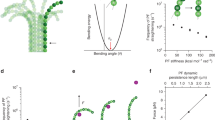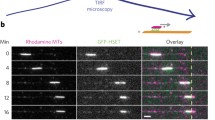Abstract
Chromosome segregation during mitosis is mediated by spindle microtubules that attach to chromosomal kinetochores with strong yet labile links. The exact molecular composition of the kinetochore–microtubule interface is not known but microtubules are thought to bind to kinetochores via the specialized microtubule-binding sites, which contain multiple microtubule-binding proteins. During prometaphase the lifetime of microtubule attachments is short but in metaphase it increases 3-fold, presumably owing to dephosphorylation of the microtubule-binding proteins that increases their affinity. Here, we use mathematical modeling to examine in quantitative and systematic manner the general relationships between the molecular properties of microtubule-binding proteins and the resulting stability of microtubule attachment to the protein-containing kinetochore site. We show that when the protein connections are stochastic, the physiological rate of microtubule turnover is achieved only if these molecular interactions are very transient, each lasting fraction of a second. This “microscopic” time is almost four orders of magnitude shorter than the characteristic time of kinetochore–microtubule attachment. Cooperativity of the microtubule-binding events further increases the disparity of these time scales. Furthermore, for all values of kinetic parameters the microtubule stability is very sensitive to the minor changes in the molecular constants. Such sensitivity of the lifetime of microtubule attachment to the kinetics and cooperativity of molecular interactions at the microtubule-binding site may hinder the accurate regulation of kinetochore–microtubule stability during mitotic progression, and it necessitates detailed experimental examination of the microtubule-binding properties of kinetochore-localized proteins.





Similar content being viewed by others
Abbreviations
- MAP:
-
Microtubule-associated protein
- MT:
-
Microtubule
- KMT:
-
Kinetochore microtubule
References
Akiyoshi, B., K. K. Sarangapani, A. F. Powers, C. R. Nelson, S. L. Reichow, H. Arellano-Santoyo, T. Gonen, J. A. Ranish, C. L. Asbury, and S. Biggins. Tension directly stabilizes reconstituted kinetochore–microtubule attachments. Nature 468(7323):576–579, 2010.
Alberts, B., A. Johnson, J. Lewis, M. Raff, K. Roberts, and P. Walter. Molecular Biology of the Cell (5th ed.). New York: Garland Science, pp. 1082–1086, 2008.
Alushin, G. M., V. Musinipally, D. Matson, J. Tooley, P. T. Stukenberg, and E. Nogales. Multimodal microtubule binding by the Ndc80 kinetochore complex. Nat. Struct. Mol. Biol. 19(11):1161–1167, 2012.
Alushin, G. M., V. H. Ramey, S. Pasqualato, D. A. Ball, N. Grigorieff, A. Musacchio, and E. Nogales. The Ndc80 kinetochore complex forms oligomeric arrays along microtubules. Nature 467(7317):805–810, 2010.
Aravamudhan, P., I. Felzer-Kim, and A. P. Joglekar. The budding yeast point centromere associates with two Cse4 molecules during mitosis. Curr. Biol. 23(9):770–774, 2013.
Armond, J. W., and M. S. Turner. Force transduction by the microtubule-bound Dam1 ring. Biophys. J . 98(8):1598–1607, 2010.
Bakhoum, S. F., G. Genovese, and D. A. Compton. Deviant kinetochore microtubule dynamics underlie chromosomal instability. Curr. Biol. 19(22):1937–1942, 2009.
Bakhoum, S. F., S. L. Thompson, A. L. Manning, and D. A. Compton. Genome stability is ensured by temporal control of kinetochore–microtubule dynamics. Nat. Cell Biol. 11(1):27–35, 2009.
Cheeseman, I. M., S. Anderson, M. Jwa, E. M. Green, J. Kang, J. R. Yates, 3rd, C. S. Chan, D. G. Drubin, and G. Barnes. Phospho-regulation of kinetochore-microtubule attachments by the Aurora kinase Ipl1p. Cell 111(2):163–172, 2002.
Cheeseman, I. M., J. S. Chappie, E. M. Wilson-Kubalek, and A. Desai. The conserved KMN network constitutes the core microtubule-binding site of the kinetochore. Cell 127(5):983–997, 2006.
Cimini, D., X. Wan, C. B. Hirel, and E. D. Salmon. Aurora kinase promotes turnover of kinetochore microtubules to reduce chromosome segregation errors. Curr. Biol. 16(17):1711–1718, 2006.
Civelekoglu-Scholey, G., B. He, M. Shen, X. Wan, E. Roscioli, B. Bowden, and D. Cimini. Dynamic bonds and polar ejection force distribution explain kinetochore oscillations in PtK1 cells. J. Cell Biol. 201(4):577–593, 2013.
DeLuca, J. G., W. E. Gall, C. Ciferri, D. Cimini, A. Musacchio, and E. D. Salmon. Kinetochore microtubule dynamics and attachment stability are regulated by Hec1. Cell 127(5):969–982, 2006.
Dong, Y., K. J. Vanden Beldt, X. Meng, A. Khodjakov, and B. F. McEwen. The outer plate in vertebrate kinetochores is a flexible network with multiple microtubule interactions. Nat. Cell Biol. 9(5):516–522, 2007.
Efremov, A., E. L. Grishchuk, J. R. McIntosh, and F. I. Ataullakhanov. In search of an optimal ring to couple microtubule depolymerization to processive chromosome motions. Proc. Natl. Acad. Sci. U.S.A. 104(48):19017–19022, 2007.
Franck, A. D., A. F. Powers, D. T. Gestaut, T. Gonen, T. N. Davis, and C. L. Asbury. Tension applied through the Dam1 complex promotes microtubule elongation providing a direct mechanism for length control in mitosis. Nat. Cell Biol. 9(7):832–837, 2007.
Gardner, M. K., C. G. Pearson, B. L. Sprague, T. R. Zarzar, K. Bloom, E. D. Salmon, and D. J. Odde. Tension-dependent regulation of microtubule dynamics at kinetochores can explain metaphase congression in yeast. Mol. Biol. Cell 16:3764–3775, 2005.
Grishchuk, E. L., J. R. McIntosh, M. I. Molodtsov, and F. I. Ataullakhanov. Comprehensive Biophysics, Vol. 4. Amsterdam: Elsevier, pp. 93–117, 2012.
Hill, A. V. The possible effects of the aggregation of the molecules of haemoglobin on its dissociation curves. J. Physiol. 40:iv–vii, 1910.
Hill, T. L. Theoretical problems related to the attachment of microtubules to kinetochores. Proc. Natl. Acad. Sci. U.S.A. 82:4404–4408, 1985.
Joglekar, A. P., and A. J. Hunt. A simple, mechanistic model for directional instability during mitotic chromosome movements. Biophys. J . 83(1):42–58, 2002.
Johnston, K., A. Joglekar, T. Hori, A. Suzuki, T. Fukagawa, and E. D. Salmon. Vertebrate kinetochore protein architecture: protein copy number. J. Cell Biol. 189(6):937–943, 2010.
Jordan, M. A., and K. Kamath. How do microtubule-targeted drugs work? An overview. Curr. Cancer Drug Targets 7(8):730–742, 2007.
Lawrimore, J., K. S. Bloom, and E. D. Salmon. Point centromeres contain more than a single centromere-specific Cse4 (CENP-A) nucleosome. J. Cell Biol. 195(4):573–582, 2011.
Liu, J., and J. N. Onuchic. A driving and coupling “Pac-Man” mechanism for chromosome poleward translocation in anaphase A. Proc. Natl. Acad. Sci. U.S.A. 103(49):18432–18437, 2006.
McDonald, K. L., E. T. O’Toole, D. N. Mastronarde, and J. R. McIntosh. Kinetochore microtubules in PTK cells. J. Cell Biol. 118(2):369–383, 1992.
McEwen, B. F., A. B. Heagle, G. O. Cassels, K. F. Buttle, and C. L. Rieder. Kinetochore fiber maturation in PtK1 cells and its implications for the mechanisms of chromosome congression and anaphase onset. J. Cell Biol. 137(7):1567–1580, 1997.
McIntosh, J. R., E. L. Grishchuk, M. K. Morphew, A. K. Efremov, K. Zhudenkov, V. A. Volkov, I. M. Cheeseman, A. Desai, D. N. Mastronarde, and F. I. Ataullakhanov. Fibrils connect microtubule tips with kinetochores: a mechanism to couple tubulin dynamics to chromosome motion. Cell 135(2):322–333, 2008.
McIntosh, J. R., E. L. Grishchuk, and R. R. West. Chromosome-microtubule interactions during mitosis. Annu. Rev. Cell Dev. Biol. 18:193–219, 2002.
McIntosh, J. R., E. O’Toole, K. Zhudenkov, M. Morphew, C. Schwartz, F. I. Ataullakhanov, and E. L. Grishchuk. Conserved and divergent features of kinetochores and spindle microtubule ends from five species. J. Cell Biol. 200(4):459–474, 2013.
Molodtsov, M. I., E. L. Grishchuk, A. K. Efremov, J. R. McIntosh, and F. I. Ataullakhanov. Force production by depolymerizing microtubules. Proc. Natl. Acad. Sci. U.S.A. 102(12):4353–4358, 2005.
Nicklas, R. B. Chromosome velocity during mitosis as a function of chromosome size and position. J. Cell Biol. 25:119–135, 1965.
Powers, A. F., A. D. Franck, D. R. Gestaut, J. Cooper, B. Gracyzk, R. R. Wei, L. Wordeman, T. N. Davis, and C. L. Asbury. The Ndc80 kinetochore complex forms load-bearing attachments to dynamic microtubule tips via biased diffusion. Cell 136(5):865–875, 2009.
Rank, K. C., and I. Rayment. Functional asymmetry in kinesin and dynein dimers. Biol. Cell 105(1):1–13, 2013.
Santaguida, S., and A. Musacchio. The life and miracles of kinetochores. EMBO J. 28(17):2511–2531, 2009.
Schmidt, J. C., H. Arthanari, A. Boeszoermenyi, N. M. Dashkevich, E. M. Wilson-Kubalek, N. Monnier, M. Markus, M. Oberer, R. A. Milligan, M. Bathe, G. Wagner, E. L. Grishchuk, and I. M. Cheeseman. The kinetochore-bound Ska1 complex tracks depolymerizing microtubules and binds to curved protofilaments. Dev. Cell 23(5):968–980, 2012.
Shen, Q. T., P. P. Hsiue, C. V. Sindelar, M. D. Welch, K. G. Campellone, and H. W. Wang. Structural insights into WHAMM-mediated cytoskeletal coordination during membrane remodeling. J. Cell Biol. 199(1):111–124, 2012.
Shivaraju, M., J. R. Unruh, B. D. Slaughter, M. Mattingly, J. Berman, and J. L. Gerton. Cell-cycle-coupled structural oscillation of centromeric nucleosomes in yeast. Cell 150(2):304–316, 2012.
Shtylla, B., and J. P. Keener. A mechanomolecular model for the movement of chromosomes during mitosis driven by a minimal kinetochore bicyclic cascade. J. Theor. Biol. 263(4):455–470, 2010.
Thompson, S. L., S. F. Bakhoum, and D. A. Compton. Mechanisms of chromosomal instability. Curr. Biol. 20(6):R285–R295, 2010.
Umbreit, N. T., D. R. Gestaut, J. F. Tien, B. S. Vollmar, T. Gonen, C. L. Asbury, and T. N. Davis. The Ndc80 kinetochore complex directly modulates microtubule dynamics. Proc. Natl. Acad. Sci. U.S.A. 109(40):16113–16118, 2012.
Volkov, V. A., A. V. Zaytsev, N. Gudimchuk, P. M. Grissom, A. L. Gintsburg, F. I. Ataullakhanov, J. R. McIntosh, and E. L. Grishchuk. Long tethers provide high-force coupling of the Dam1 ring to shortening microtubules. Proc. Natl. Acad. Sci. U.S.A. 110(19):7708–7713, 2013.
Wan, X., R. P. O’Quinn, H. L. Pierce, A. P. Joglekar, W. E. Gall, J. G. DeLuca, C. W. Carroll, S. T. Liu, T. J. Yen, B. F. McEwen, P. T. Stukenberg, A. Desai, and E. D. Salmon. Protein architecture of the human kinetochore microtubule attachment site. Cell 137(4):672–684, 2009.
Westermann, S., H. W. Wang, A. Avila-Sakar, D. G. Drubin, E. Nogales, and G. Barnes. The Dam1 kinetochore ring complex moves processively on depolymerizing microtubule ends. Nature 440(7083):565–569, 2006.
Wilson-Kubalek, E. M., I. M. Cheeseman, C. Yoshioka, A. Desai, and R. A. Milligan. Orientation and structure of the Ndc80 complex on the microtubule lattice. J. Cell Biol. 182(6):1055–1061, 2008.
Wollman, R., G. Civelekoglu-Scholey, J. M. Scholey, and A. Mogilner. Reverse engineering of force integration during mitosis in the Drosophila embryo. Mol. Syst. Biol. 4:195, 2008.
Zhai, Y., P. J. Kronebusch, and G. G. Borisy. Kinetochore microtubule dynamics and the metaphase–anaphase transition. J. Cell Biol. 131(3):721–734, 1995.
Zinkowski, R. P., J. Meyne, and B. R. Brinkley. The centromere–kinetochore complex: a repeat subunit model. J. Cell Biol. 113(5):1091–1110, 1991.
Acknowledgments
We thank members of the Grishchuk and Ataullakhanov laboratories, J. DeLuca and E. Ballister for stimulating discussions; A. Potapenko for reading of the manuscript; J.R. McIntosh for supporting this project (GM033787). This work was supported by National Institutes of Health Grant GM098389 to ELG, by Russian Academy of Sciences Presidium Grants “Mechanisms of the Molecular Systems Integration” and “Molecular and Cell Biology programs” and by Russian Fund for Basic Research Grant 12-04-00111-a to FIA. ELG is a Kimmel Scholar.
Author information
Authors and Affiliations
Corresponding author
Additional information
Associate Editor David Odde oversaw the review of this article.
Rights and permissions
About this article
Cite this article
Zaytsev, A.V., Ataullakhanov, F.I. & Grishchuk, E.L. Highly Transient Molecular Interactions Underlie the Stability of Kinetochore–Microtubule Attachment During Cell Division. Cel. Mol. Bioeng. 6, 393–405 (2013). https://doi.org/10.1007/s12195-013-0309-4
Received:
Accepted:
Published:
Issue Date:
DOI: https://doi.org/10.1007/s12195-013-0309-4




